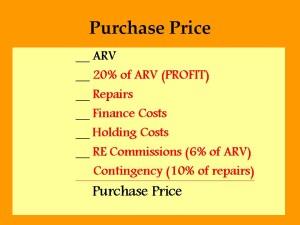Unfortunately for us, so many people today rely on television as their guiding light, their beacon of truth – so to speak. If it looks easy on TV, well then it must be easy. Relative to real estate investing, this couldn’t be any more so with regard to a technique we refer to as Flipping. I couldn’t begin to name all of the shows that have cashed-in on the flipping craze. And they all depict flipping as glamorous and easy.
The essence of flipping, the technique otherwise known as Fix and Flip, is to purchase a property, usually a single family residence, and then do something to it in a way of physical improvements in order to sell it for a profit. Well, let me tell you something – flipping is a lot of things, but easy it is not. In fact, whenever asked I tell people that flipping should be left to the pros. To do it correctly and consistently profitably requires deep funding, teams of people, and well-developed businesses systems with built-in redundancy.
The big issue with flipping, and what makes flipping so incredibly challenging, is that there is very little room for mistakes. In the world of investing, the only two elements which off-set risk are time and availability of multiple exit strategies. In flipping, however, the only exit strategy is to sell the house – the entire model is based on this. If you can’t sell, you don’t make money. Not only that, but you have to manage this on a time-table otherwise the carrying costs become too burdensome. This is dangerous…
Let us consider just one potential problem area from the long list of things that could go wrong. This is where a lot of beginners make a mistake – determining how much to pay for the house in the first place.
The way flipping should work is that we first must establish the After Repair Value (ARV), which is the price for which our flip will sell quickly once we are finished doing whatever improvements we have planned. After establishing the ARV, we can then subtract from it all of the costs associated with performing our flip which include among them things like repair costs, financing charges, holding costs, and real estate commissions, to arrive at the price that we can afford to pay for our flip.
The process of estimating the ARV is like walking a tight-rope. There are only three ways to go about, and only one way is the right way. One way to do this is to ask your real estate sales agent. Another is to conduct market research. And finally, you could always just guess.
You would be absolutely amazed at how many flippers get this wrong. This is flipping 101, and yet a lot of what’s going on out there sure looks like guessing to me. At best, people just ask their sales agent, the same one that is selling them this flip, to tell them what this flip will sell for when complete. This is better than guessing, but if you do this, you are asking your sales agent to advise you on an investment. Nothing against agents, I am one of them, but most agents wouldn’t know a good investment if it hit them in the head.
Here’s what you should do: ask your agent for a printout of all of the properties that are similar to the one you are considering, which have sold in the location over the three months prior. Armed with this data, you will need to conduct a Comparative Market Analysis (CMA) and arrive at what you believe to be the likely ARV. If you don’t know how to do this, please consider purchasing the Cash Flow Freedom University in which I walk you through this process.
There are no shortcuts in real estate investing, and especially not in flipping. Unless you are willing to educate yourself and put in the time to do the proper research and develop proper systems, stay away from flipping!
© Copyright 2013 Ben Leybovich and Just Ask Ben Why. All Rights Reserved.


16 Comments